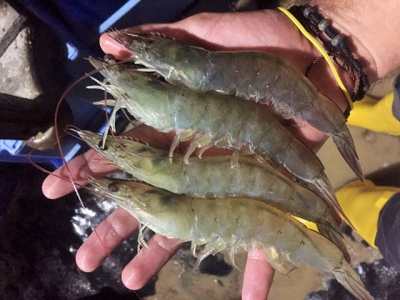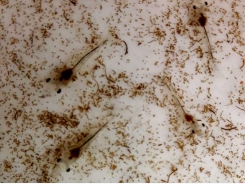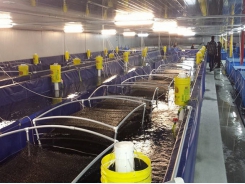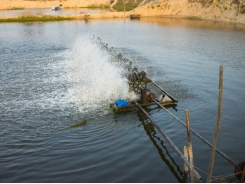Current production, challenges and the future of shrimp farming

Advocate Editor Emeritus addresses first Aquaculture Symposium in Guatemala
Shrimp was the central topic of the recent symposium in Antigua, Guatemala. Photo by Fernando Huerta.
In early June I participated in the first Guatemalan Aquaculture Symposium, organized by AGEXPORT, the Guatemalan Association of Exporters, which promotes the country’s export of products and services. Nearly three dozen speakers gave talks on shrimp and tilapia farming to the more than 400 participants – representing mostly producers, industry suppliers and researchers from the Central America region as well as the United States, Mexico, Colombia, Ecuador, Peru, Brazil, Venezuela, Thailand and other countries – who also enjoyed a well-organized trade show with key industry suppliers.
This first-ever event was held in the beautiful city of Antigua, famous for its colonial Spanish architecture, ruins and churches and designated a UNESCO World Heritage Site. The event took place just days after the recent and deadly eruption of the nearby Fuego Volcano.
The program heavily reflected the importance of farmed shrimp – and to a somewhat lesser extent tilapia – to Guatemala and the region. Topics included in the presentations included in depth reviews of the global status of the shrimp industry, genetic improvement, nutrition, health management, production systems, investment and others. It should be noted that Guatemala has experienced a recent, major development of its shrimp farming industry towards intensification (and this will be the subject of an upcoming article), and is the leader of intensive shrimp farming in the region.
In my invited keynote presentation “Current Production, Challenges and the Future of Shrimp Farming,” I discussed some current production data and trends in the main shrimp producing regions and countries, and some of the major issues affecting industry development – like diseases, aquafeed ingredients investment and the need to expand consumption and markets – as well as some perspectives to sustain industry expansion and consolidation.
The global shrimp farming industry
Globally, shrimp have been farmed for several decades and there currently is production in at least 50 countries around the world, although the industry is concentrated in two major regions, Asia and the Americas. Table 1 shows the estimated global production of farmed shrimp from The Global Aquaculture Alliance’s GOAL 2016 and 2017 surveys, and percent distribution by major producing regions.
Total global production in 2016 was 4,055,690 metric tons (MT) and it increased by about 5 percent to 4,267,500 MT in 2017. Asian countries (China, Thailand, Vietnam, Indonesia, Malaysia, Philippines, India and Bangladesh, mainly) accounted for about 3.42 million metric tons (MMT) or about 80.1 percent of global production in 2017. The Americas (Ecuador, Mexico, Brazil, Venezuela, Honduras, Nicaragua, Guatemala, Belize, Panama, Peru and others) produced about 756,430 MT or 17.7 percent; and the rest of the world accounted for around 85,000 MT or about 2 percent of the total.
Jory, Global shrimp production, Table 1
| Region | Production 2016 (MT) | % Global 2016 | Production 2017 (MT) | % Global 2017 |
| Southeast Asia | 1,483,935 | 36.6 | 1,574,077 | 36.9 |
| China | 1,352,762 | 33.4 | 1,350,622 | 31.6 |
| India | 438,579 | 10.8 | 494,959 | 11.6 |
| Americas | 701,200 | 17.3 | 756,430 | 17.7 |
| MENA | 53,796 | 1.3 | 63,990 | 1.5 |
| Others | 25,419 | 0.6 | 27,422 | 0.06 |
| TOTAL | 4,055,690 | 100 | 4,267,500 | 100 |
Table 1. Estimated global production of farmed shrimp (GOAL surveys from 2016 and 2017) and percent distribution by major producing regions.
Total pond area devoted to shrimp farming was recently estimated at around 2,135,110 hectares by Boyd and McNevin. The annual value of farmed shrimp in 2014 was estimated at $23.6 billion in 2014, second only to the carps (FAO 2016, Tacon 2016).
The Pacific white shrimp (Litopenaeus vannamei) was the main aquatic species cultivated in the world in value at $18,460 million in 2014 (FAO 2016, Tacon 2016), and also the most commercially important shrimp species in the world, with practically all the production coming from aquaculture (over 76 percent of all farmed shrimp, and over 45 percent of all shrimp produced globally, including fisheries and aquaculture production).
Much more additional, farmed shrimp-related economic activity is focused on auxiliary and value chain industries such as aquafeeds, equipment, pharmaceuticals, chemicals, transport, marketing, R&D and others. And farmed shrimp supports at least an estimated 2.5 million direct jobs, and many more indirectly.
Production technology continues to be mostly extensive to semi-intensive, and there is much potential to improve efficiency through innovation and standardization of procedures (continuing the transition from artisanal to industrial scale). Knowledge about nutritional needs is adequate, but there is room for improvement.
The history of the industry is one of periodic outbreaks of strong diseases and continuing health management problems that disrupt supply chains and markets and is of great concern to potential investors. There are relatively few available proactive alternatives apart from biosecurity and genetic selection measures.
Although the industry is based mostly on a single species, with relatively few genetically selected and improved lines, there is much potential for additional genetic gains to significantly improve production (growth rates, disease resistance, others) due to the relatively short life cycle of the animals.
The industry can could expand significantly through adequate investment levels and expanded market support and demand.
Industry challenges
The shrimp farming industry globally faces numerous challenges, most importantly various viral, bacterial and fungal diseases; also, the need for additional, novel ingredients that will be needed to manufacture and support a growing demand for aquafeeds; and environmental impact, markets and investment issues.
Diseases and aquafeed ingredients are undoubtedly the most important challenges currently faced by the shrimp industry. The history of the industry has been one of serious, periodic global pandemics and diseases have been a significant industry driver from the beginning. Various diseases will continue to be relevant drivers, but when we examine the industry’s tract record over the last two decades of commercial existence – when production has been quadrupled or more – despite facing various serious diseases, we know the industry will continue to learn how to manage and coexist with disease as it keeps growing globally.
The last decade or so has seen the emergence of two new and very serious diseases, the EMS/AHPND disease (Early Mortality Syndrome/Acute Hepatopancreatic Necrosis Disease) caused by a bacterium, Vibrio parahaemolyticus; and a new disease called Hepatopancreatic Microsporidiosis (HPM) caused by a small (1 micron), intracellular, spore-forming microsporidian parasite (Enterocytozoon hepatopenaei, or EHP). Countries like Thailand and others have shown the way regarding how to successfully manage these new diseases. But it is very important that various countries where these diseases are very likely present acknowledge their presence as the first step to effectively managing them.
The availability of enough aquafeed ingredients is the other major challenge I think requires attention. Aquafeed demand has expanded significantly during the last three decades – the FAO’s The State of World Fisheries and Aquaculture 2016 report shows that production of farmed, fed aquatic species is growing significantly – and current global aquafeed production is about 4 percent of the global animal feed production of 1.08 billion metric tons, according to the 2018 Alltech Global Feed Survey.
A significant amount of additional ingredients for aquafeeds will originate from a combination of increased production from established suppliers like various land-based activities like agriculture, through increased production of major current ingredients like soybeans and other crops, from processed animal by-products, and from new ingredients like bacterial products, insect meals and others. Land-based production of feed ingredients has several important advantages over other ingredient sources, because significant planning and control is possible, and land-based agriculture is expandable, sustainable, responsible and certifiable.
The future, today
Improving shrimp lines is a top consideration and farmed shrimp species have much potential for further genetic improvement through a variety of old and new technologies, including traditional genetic technologies like selective breeding, genome-based genetic selection and more the advanced genome editing tools like CRISPR/Cas9 (Clustered Regularly Inter-spaced Short Palindromic Repeats) and TALEN (Transcription activator-like effector nucleases) – all of which can lead to gains in growth rates, resistance and other desirable selection traits.
Shrimp’s relatively short generation time greatly assists in their selective breeding efforts. The development of improved lines of specific pathogen-free (SPF), specific pathogen-resistant (SPR and specific pathogen-tolerant (SPT) animals, and breeding for improved performance in specific culture environments will continue to be relevant, as will be increased application of genomics, nutrigenomics and proteomics.
Healthier shrimp are possible through improved biosecurity, from pond to zone management. Other areas for improvement include better pathogen detection and a better understanding of their mode of action; effective use of immunostimulants and probiotics, and even the development of vaccines now appears not so far-fetched.
There is much room to improve grow-out technologies by increasing water reuse and with multi-phased production strategies using nursery systems. The industry can expand by growing near major consumption centers and through intensification, just like Guatemalan shrimp farmers are doing.
Meeting increasing consumer expectations regarding wholesomeness, sustainability and responsibility is crucial, and proper certification an increasingly valuable tool to achieve these goals.
Our knowledge of shrimp’s nutritional requirements continues to expand, with a better understanding of the relevance of gut health. Novel ingredients and improved feed manufacturing processes, functional feeds (targeting seasons, stress, immunomodulation and others), with improved delivery/management of feeds including precision feeding and automated feeding systems, which are quickly gaining much popularity as their numerous benefits are better understood.
Regarding global shrimp markets, we can definitively expand them, but we need to offer consistent availability and quality, as well as more, novel value-added, “convenient” products. Gaining market share in the growing fast-food sector is key to expand shrimp demand and consumption; and as well, shrimp can and should increase its presence in the domestic markets of many countries. New technologies like those that can extend the shelf-life of fresh products (e.g. modified atmosphere packaging) have the potential to transform how we package, transport, store and market our products.
We have a great story to tell, and we must tell it better and to a wider audience emphasizing the human health, community and environmental benefits of our industry. How many of us, for example, can support with facts the benefits of shrimp consumption to most people?
Perspectives
We need more aquaculture production from several key species, including shrimp and tilapia, to support global population growth, and we have increased the production of farmed shrimp globally by about four times compared to 1995 levels. Global production of farmed shrimp will continue to expand, with more efficiency at every level of production and marketing, and increased industry consolidation. Faster-growing, more disease-resistant animals developed for specific growing conditions, as well as improved product characteristics (e.g. higher omega-3 fatty acid content) would be a plus for marketing and increasing consumer demand.
Shrimp hatcheries must better address the issue of live foods production, including increased replacement of live feeds and biosecurity. The grow-out segment must work to reduce the culture time through selective breeding, improved production management, efficiency, biosecurity, health management and survival.
Diseases are part of the industry and many new support technologies – including developments in genetic improvement and selection of cultured animals and a variety of species that provide feed ingredients – will help the industry grow in many regions with appropriate investment and market development.Shrimp markets and global consumption can be expanded by developing internal markets and new export markets in Asia, Africa, the Middle East and other areas. New and more convenient, ready-to-eat products, new packaging and transport technologies, and better promotion (telling our story better) will help expand markets and consumption.
Gaining access to new generations and making them strong consumers is critical, as is continued innovation along the entire production and marketing chain. Meeting increasing consumer expectations regarding wholesomeness, sustainability and responsibility is crucial, and proper certification an increasingly valuable tool to achieve these goals. The shrimp industry has significant potential to expand global production, both through the development of new locations and by responsible intensification of production technology and procedures.
Related news
Tools

Phối trộn thức ăn chăn nuôi

Pha dung dịch thủy canh

Định mức cho tôm ăn

Phối trộn phân bón NPK

Xác định tỷ lệ tôm sống

Chuyển đổi đơn vị phân bón

Xác định công suất sục khí

Chuyển đổi đơn vị tôm

Tính diện tích nhà kính

Tính thể tích ao




 Novel probiotic strain may boost shrimp performance, inhibit…
Novel probiotic strain may boost shrimp performance, inhibit…  Early feed restriction may program shrimp for growth
Early feed restriction may program shrimp for growth